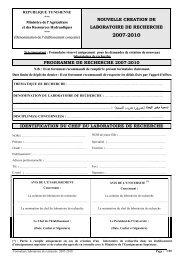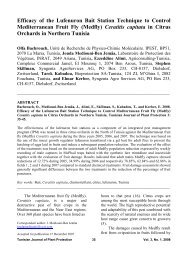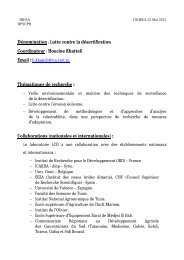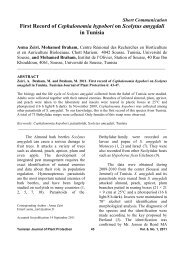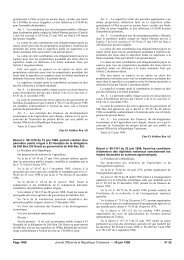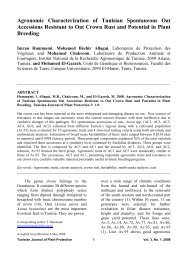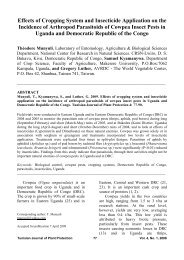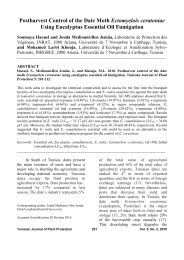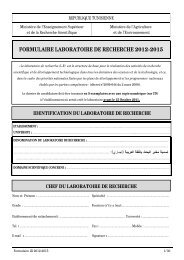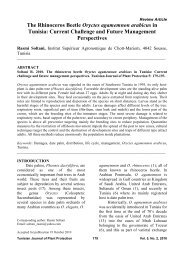Seasonal Abundance Patterns of Insects and Mites on Pear ... - Iresa
Seasonal Abundance Patterns of Insects and Mites on Pear ... - Iresa
Seasonal Abundance Patterns of Insects and Mites on Pear ... - Iresa
Create successful ePaper yourself
Turn your PDF publications into a flip-book with our unique Google optimized e-Paper software.
increased from the beginning <str<strong>on</strong>g>of</str<strong>on</strong>g> the<br />
seas<strong>on</strong>, with an average <str<strong>on</strong>g>of</str<strong>on</strong>g> 0.07 individuals<br />
to reach its peak <str<strong>on</strong>g>of</str<strong>on</strong>g> 0.89 individuals in the<br />
first <str<strong>on</strong>g>of</str<strong>on</strong>g> June <str<strong>on</strong>g>and</str<strong>on</strong>g> decreased to 0.63<br />
individuals by the end <str<strong>on</strong>g>of</str<strong>on</strong>g> the seas<strong>on</strong>. Scale<br />
insects occurred rarely during the study.<br />
Psylla was recorded in the sec<strong>on</strong>d decade<br />
<str<strong>on</strong>g>of</str<strong>on</strong>g> April, with an average <str<strong>on</strong>g>of</str<strong>on</strong>g> 1.08<br />
individuals <str<strong>on</strong>g>and</str<strong>on</strong>g> slightly decreased to the<br />
end <str<strong>on</strong>g>of</str<strong>on</strong>g> seas<strong>on</strong> (0.32 individuals). The<br />
aphids did not occur regularly <str<strong>on</strong>g>and</str<strong>on</strong>g> was<br />
present in fewer numbers than in the new<br />
orchard.<br />
DISCUSSION<br />
The survey <str<strong>on</strong>g>of</str<strong>on</strong>g> insect <str<strong>on</strong>g>and</str<strong>on</strong>g> mite pests<br />
revealed that the most important pests<br />
attacking pear trees (from initiati<strong>on</strong> sap<br />
flowing, swelling buds <str<strong>on</strong>g>and</str<strong>on</strong>g> developing<br />
leaves until fruiting) bel<strong>on</strong>ged to 5 insect<br />
orders <str<strong>on</strong>g>and</str<strong>on</strong>g> <strong>on</strong>e order (Parasitiformes)<br />
bel<strong>on</strong>ging to class Acari. The main insect<br />
order Homoptera included six families <str<strong>on</strong>g>of</str<strong>on</strong>g><br />
Homoptera (Aphididae, Pseudococcidae,<br />
Diaspididae, Coccidae, Cicadellidae <str<strong>on</strong>g>and</str<strong>on</strong>g><br />
Psyllidae) besides the orders <str<strong>on</strong>g>of</str<strong>on</strong>g><br />
Thysanoptera, Diptera, Coleoptera <str<strong>on</strong>g>and</str<strong>on</strong>g><br />
Isoptera.<br />
This pseudococcid is distributed<br />
throughout southern Europe, South <str<strong>on</strong>g>and</str<strong>on</strong>g><br />
North <str<strong>on</strong>g>of</str<strong>on</strong>g> America, the Middle East <str<strong>on</strong>g>and</str<strong>on</strong>g><br />
parts <str<strong>on</strong>g>of</str<strong>on</strong>g> Africa (15). It is a polyphagous<br />
insect with a wide range <str<strong>on</strong>g>of</str<strong>on</strong>g> host plants (21)<br />
such as grapes, figs, apples, <str<strong>on</strong>g>and</str<strong>on</strong>g> citrus, as<br />
well as more tropical crops such as yams,<br />
mangos, <str<strong>on</strong>g>and</str<strong>on</strong>g> avocados (10). It causes<br />
direct crop loss <str<strong>on</strong>g>of</str<strong>on</strong>g> grapes due to<br />
desiccati<strong>on</strong> <str<strong>on</strong>g>of</str<strong>on</strong>g> bunches <str<strong>on</strong>g>and</str<strong>on</strong>g> unsightly<br />
h<strong>on</strong>eydew excreti<strong>on</strong>. In Egypt, it becomes<br />
an ec<strong>on</strong>omic pest (2), especially in the<br />
newly-reclaimed areas.<br />
It was reported (3, 5) that successful<br />
initiati<strong>on</strong> <str<strong>on</strong>g>of</str<strong>on</strong>g> nymphal feeding <str<strong>on</strong>g>and</str<strong>on</strong>g><br />
h<strong>on</strong>eydew producti<strong>on</strong> were str<strong>on</strong>g<br />
indicators <str<strong>on</strong>g>of</str<strong>on</strong>g> host suitability. Large<br />
numbers <str<strong>on</strong>g>of</str<strong>on</strong>g> winterforms leave pear orchard<br />
in autumn to overwinter in other habitats,<br />
<str<strong>on</strong>g>and</str<strong>on</strong>g> return to pear orchards the following<br />
spring (11). The pear psylla secretes<br />
h<strong>on</strong>eydew, which serves as a substratum<br />
for the growth <str<strong>on</strong>g>of</str<strong>on</strong>g> a black fungus that gives<br />
the tree a smoky, sooty appearance.<br />
Foliage may wilt <str<strong>on</strong>g>and</str<strong>on</strong>g> drop to the ground.<br />
Trees that are heavily infested since a l<strong>on</strong>g<br />
time show a reduced growth <str<strong>on</strong>g>and</str<strong>on</strong>g> produce<br />
fewer fruit buds. Fruit remains small, fails<br />
to mature <str<strong>on</strong>g>and</str<strong>on</strong>g> may fall <str<strong>on</strong>g>of</str<strong>on</strong>g>f the tree when<br />
<strong>on</strong>ly partly grown. The tree shows<br />
symptoms from "psylla shock" caused by<br />
toxic saliva. Prol<strong>on</strong>ged infestati<strong>on</strong>s may<br />
kill trees (12). It was stated that the mainly<br />
phytophagous species <strong>on</strong> pear trees were<br />
psylla <str<strong>on</strong>g>and</str<strong>on</strong>g> aphids (14, 18).<br />
Few numbers <str<strong>on</strong>g>of</str<strong>on</strong>g> the Florida wax scale<br />
insect, Ceroplastes floridensis (Coccidae)<br />
were observed <strong>on</strong> the wood <str<strong>on</strong>g>and</str<strong>on</strong>g> leaves. It<br />
was recorded that the scale insects such as<br />
Chrysomphalus ficus <str<strong>on</strong>g>and</str<strong>on</strong>g> C. floridensis<br />
attack pear trees (10). <strong>Pear</strong> trees were also<br />
subjected to infestati<strong>on</strong> by the stem borer,<br />
Scolytus aegyptiacus (Scolytidae). which<br />
causes a serious damage to this species <str<strong>on</strong>g>of</str<strong>on</strong>g><br />
tree (9).<br />
Ceratitis capitata is a comm<strong>on</strong><br />
polyphagous pest attacking more than 250<br />
species <str<strong>on</strong>g>of</str<strong>on</strong>g> commercial fruits growing in<br />
the Mediterranean area (8, 13). It was<br />
menti<strong>on</strong>ed that the important hosts for the<br />
summer generati<strong>on</strong>s <str<strong>on</strong>g>of</str<strong>on</strong>g> this fly are peach,<br />
fig, <str<strong>on</strong>g>and</str<strong>on</strong>g> in autumn, pear <str<strong>on</strong>g>and</str<strong>on</strong>g> apple (17).<br />
The workers <str<strong>on</strong>g>of</str<strong>on</strong>g> the termite attack vineyard<br />
trees, especially at the newly reclaimed<br />
l<str<strong>on</strong>g>and</str<strong>on</strong>g>s (20). (19) <str<strong>on</strong>g>Mites</str<strong>on</strong>g> Cenopalpus pulcher<br />
<strong>on</strong> apple <str<strong>on</strong>g>and</str<strong>on</strong>g> Tetranychus urticae <strong>on</strong> pear<br />
were recorded at Ismailia (19), while the<br />
species Cenopalpus lanceolatisetae was<br />
observed <strong>on</strong> pear trees at Giza (22).<br />
The populati<strong>on</strong> dynamics <str<strong>on</strong>g>and</str<strong>on</strong>g> the<br />
degree <str<strong>on</strong>g>of</str<strong>on</strong>g> infestati<strong>on</strong> by various pests were<br />
related to weather c<strong>on</strong>diti<strong>on</strong>s. The<br />
recorded pests reached their maximum<br />
populati<strong>on</strong>s in the sec<strong>on</strong>d decade <str<strong>on</strong>g>of</str<strong>on</strong>g> May<br />
when the average <str<strong>on</strong>g>of</str<strong>on</strong>g> temperature <str<strong>on</strong>g>and</str<strong>on</strong>g><br />
relative humidity were 25ºC <str<strong>on</strong>g>and</str<strong>on</strong>g> 50.5 %<br />
RH, respectively. However, the populati<strong>on</strong><br />
dynamics <str<strong>on</strong>g>of</str<strong>on</strong>g> various pests, especially<br />
Tunisian Journal <str<strong>on</strong>g>of</str<strong>on</strong>g> Plant Protecti<strong>on</strong> 54<br />
Vol. 3, No. 1, 2008




